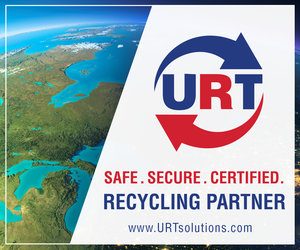The Internet of Things is the latest territory that could hold promise for enterprising electronics recycling operations. The Internet of Things (IoT) market is expected to grow from $9 billion in 2015 to $24 billion by 2021 – and to $33 billion by 2027, according to recent research.

Anne Peters, Gracestone, Inc.
That means a lot more potential items that need to be handled at end of life. But taking advantage of this opportunity comes with challenges and requires coordination.
These early days of a new electronic product category represent a chance for the electronics recovery industry to learn from the lessons of the first generations of end-of-life electronics. Stakeholders – electronics recyclers, refurbishers and component-resale shops, government officials, environmental advocates, manufacturers and others – must ensure there is adequate research, policy development, infrastructure and recoverability for the coming vast array of devices that will be part of the IoT market.
One place to start is iNEMI (the International Electronics Manufacturing Initiative). This nonprofit group is an R&D coalition of OEMs, ODMs, suppliers, trade associations and research institutions. For decades, it has released “roadmaps” – in-depth, early market studies that anticipate product and market trends with an eye to critical industry collaborations. In fact, the IoT growth statistics mentioned in the top of this piece came from iNEMI analysis.
Tellingly, the group’s roadmaps now address end of life and design-for-the-environment matters, a sign that the electronics industry as a whole may finally be treating these issues as more than an afterthought.
Clarity on categories
To fully understand the recycling potential in the development of IoT, it’s helpful to have a clear understanding of that emerging realm of electronics.
IoT is a system of networked objects and components that can interact with the physical world (through sensors and actuators) to achieve a goal. The development has potential to impact all sectors of the electronics industry, and by 2027 there are expected to be 50.1 billion connected devices.
The primary IoT segments expected to grow over the next 10 years are wearables, industrial applications, home applications, medical devices and automotive. What are the challenges and opportunities in each of these categories?
In the wearables category, products are designed to interact with smartphones via apps and include “smartbands” (think fitbits), smart watches and smart glasses. By 2019, about 1.6 billion people are expected to purchase wearables. These products have relatively short life cycles, and there may be adverse environmental impacts if enough of these flood the waste stream. At the same time, there also may be tremendous repurposing and material recovery value in these items.
Meanwhile, industrial applications for the IoT represent a seemingly endless array of opportunities for the niche electronics recovery specialist. Segments developing in the next decade include:
- Smart cities. The biggest category here is for more efficient and accurate meter-reading for utilities. Diverse applications will also emerge for emergency response, traffic and transport operations and management, lighting (street and traffic), medical/health, building energy management and more. An electronics recycling operation contracting with local governments for end-of-life materials should begin exploring deployment of these products in their clients’ cities and position themselves for additional contracts.
- Commercial applications. This tendril of the IoT vine will feature connected devices that provide energy management, HVAC and lighting controls, safety and quality control in various settings and networked communications with customers. An example given by iNEMI: The store where you bought your umbrella somehow knows that you left the house without an umbrella on a day where rain is forecast; it pings you with an address of a nearby store where you can pick up a replacement. These items may end up in both commercial and residential waste streams if thoughtful policies and reclamation strategies are not put in place.
- Heavy industry. The industrial IoT will include endless industry-specific applications, with typically longer product life times, rugged construction for harsh environments, higher reliability and bolstered safety features. Electronics recovery businesses should explore their industrial clients’ operational plans to understand new IoT technology will be deployed and to position themselves for component recovery, repurposing and resale.
Issues to consider
Some of the concerns facing manufacturers of these devices will be shared by the end of life and environmental stakeholders.
First, there are issues of trustworthiness of IoT devices that may impact market penetration: Think confidence, security, reliability, safety, privacy and functionality. A successful end-of-life infrastructure – whether for reuse, repair or recycling – must have strategies to address these needs.
Developers of the IoT are also working to solve technology challenges, including making flexible electronics, improving battery technology, addressing low-power/high performance processing needs, creating ever-higher-performing integrated circuits and smoothly integrating low-performance printed circuit boards with flexible high-performance integrated circuits.
To date, it appears that neither iNEMI nor the electronics industry has sponsored any research and development to identify end-of-life value, toxicity, processing opportunities or reuse realities. This is an excellent opportunity for leadership in the electronics recovery industry – data on wearables reuse and end-of-life features would be a great step that could be undertaken by an industry group, a government agency or another stakeholder.
Further, iNEMI has called for standards to support the growth of the IoT industry. The electronics recovery community’s stakeholders must get involved in standards development to advocate for the key characteristics that can enhance the IoT’s environmental attributes: durability, interoperability, repairability and access to repair information, identification of toxic materials and ease of disassembly.
By acting quickly and clearly, our industry can help ensure future product streams that enable profits instead of problems when items reach end of life.
Anne Peters is president at Colorado-based Gracestone, Inc., an environmentally focused consulting company. She can be contacted at [email protected].
The views and opinions expressed are those of the author and do not imply endorsement by Resource Recycling, Inc. If you have a subject you wish to cover in an op-ed, please send a short proposal to [email protected] for consideration.



